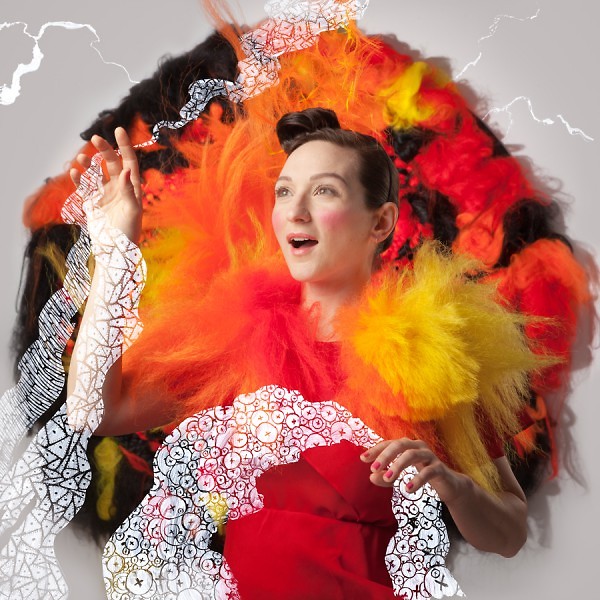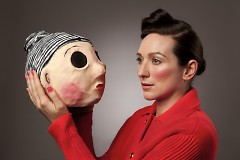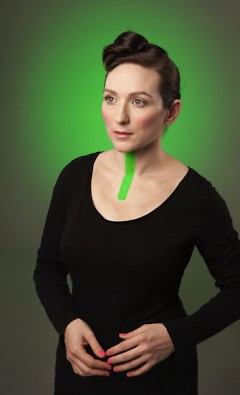Like her band name implies, My Brightest Diamond’s Shara Worden delivers multi-faceted brilliance as she weaves together rock, opera, cabaret, chamber music, and choral elements. She has been hailed as “a pensive force of nature” in the New York Times and “a creative chameleon with endless wells of technical skill” in a review on Pitchfork. Worden is a rare breed of songwriter musicians whose classically trained voice and avant-garde vision have made her a sought-after collaborator. She’s worked with numerous artists across various genres including Sufjan Stevens, The Decembrists, David Byrne, the Brooklyn Philharmonic, Bon Iver, St. Vincent and Matthew Barney. She recently released her third album, All Things Will Unwind, and is performing tonight at Calvin College. I had the chance to speak with Worden about her process and inspiration.
Tori Pelz: My access point is visual, so I’ll start there. In your album covers and performances, your styling seems to borrow heavily from commedia dell’arte with the masks, costumes, painted face... It seems that’s there’s an intention to act out this art where high art is play and vice versa…
Shara Worden: I loooove the commedia dell’arte. Love. Love. Love. It bridges that gap between theater music [and] puppetry. It’s very playful, very comic. Those are all things that I really, really love. For this record, I have been drawing from Japanese art forms: Kabuki theater, Bunraku puppetry and Butoh dance. I really love using a mask and puppetry. It allows the audience to take its gaze off me and lets people reflect on themselves in a way. It allows them to enter into a more childlike space. I’ve used the puppetry as a way to bring up ideas or more abstract concepts without using words.
TP: Visual arts obviously inform your work a great deal. I read somewhere about an instance when you were observing Anselm Keifer’s paintings and noticed his symbolic use of ladders as a reference to ascending/descending spiritual and earthly realms. You commented that in reality, these moves between the two realms are perhaps more lateral. While your work might inhabit the in-between space, the theme of ascent/descent is consistent in your work. In "A Thousand Shark’s Teeth," the song “Like a Sieve,” says that you “descend into the deep past the rushes/past the shipwrecks.” In this last album, “reaching through to the other side” is met with an “unending hymn hallelujah.” You’ve always been able to inhabit that tension between fear and beauty, but currently, there seems to be less resignation and more celebration and a quiet authority that demands the right order of things. What’s changed?
SW: A couple things. Before "Workhorse," I had someone very, very close to me die. So the first two albums are very much about grief and trying to come to acceptance. And for this album, I had a child and then six months later, my grandmother died literally one day before she turned 100. So I think my relationship with birth and death has really become a fuller picture. As more time has goes by, I’m not in excruciating agony, and I really was for a really long time. As I become more joyful and am able to see different perspectives on death, it’s reflected in the music.
TP: I know you’ve worked with Sufjan Stevens and other artists who pair lyrical vocals with larger productions that incorporate classical elements like symphonies and choirs. This is being met with more and more enthusiasm from the broader public, and I’m wondering what you think this says about pop culture’s appetite right now.
SW: Oh man, I have no idea. I really don’t feel like I understand pop culture at all. I don’t know that I’m the best… I just did this piece in Carnegie Hall with classical composer David Lang, and he brought four of us [other song-writer/musicians] together because he realized that we’re all classically trained people, and we’re all doing things in classical and pop song-writing. There are a lot of people that have classical training and have a love for classical music that also love writing songs. I think people are no longer exclusively listening to one thing. People’s ears are really wide, so the music that’s coming out is really pulling from all these different sources. Young people that grow up with the internet have had access to everything.
TP: I love how you play with words in rhythmic combinations. There’s a percussive repetition in your words and your melodies that make me think of Jay-Z and Regina Spektor. Is there anything you read or surround yourself with lyrically that helps you sustain your songwriting dexterity?
SW: Well I love Jay-Z and Regina Spektor. I don’t really read a whole lot of poetry actually. What I do read ends up kind of sticking with me for a long time. William Blake of course is amazing. Then there’s another poet, Mallermé, who I really, really love. The Debussey songs that are Mallermé have really moved me. They’re very impressionistic, very much about words and color. The sounds of the words are very important. The way the words feel in your mouth are wonderful.
TP: I’m blown away by the caliber of the people you’re working with, including visual artists Matthew Ritchie and Matthew Barney… Is there a recent collaboration that’s influencing your work at the moment?
SW: I just did the Matthew Ritchie piece like a week ago, and that was amazing. It’s been an ongoing collaboration for several years. The Matthew Barney film- I think he’s bringing my character back for a second film in the fall.
TP: Is that going to be in Detroit also?
SW: I think it’s going to be in New York. I’m just ecstatic. Because that changed my life. For sure. I don’t think that’s in this album yet. But oh my goodness. Such an incredible experience. A very difficult experience but something that continues to feed you like a year later. I keep drawing upon that experience. I play a detective. We are recovering the body of Osiris, and Osiris has been reincarnated in the body of a car. We go thru this funeral-like procession for this car that gets melted in these furnaces. We were on a barge. There’s this ritual where they blast the car with a blow torch. Kind of sacrifice of the car. We have a long processional up to the blast furnaces, and there’s music to each of these sections. The experience of music being ritual, [that it's] something that a group of people did together, this journey through time in different spaces. To engage with music on this tribal level that took place not in a concert hall but through space, and there was a process, and the audience traveled with us. And I don’t think those experiences happen very often.
TP: Makes me think a little of your rain dance in the "Be Brave" video, and it’s interesting to imagine that part of your work playing out in a public, more communal space. About Detroit: how did you decide to move there?
SW: Extremely cheap housing. Dirt, soil. I have a huge garden; I have a fruit orchard behind my house. I have neighbors that are doing organic farming [and] beekeeping. I think there’s more than fifteen hives on the block. It’s a really beautiful community of people that are really respectful and really love Detroit and care deeply about Detroit. And we’re five minutes from downtown.
TP: How has the city’s landscape or soul seeped into your latest work?
SW: Well, the song “High Low Middle” is about class. I was trying to finish up the album after I just moved here, and I went over to a friend’s house, and he gave me a lecture on Detroit’s history. He told me about this [black] doctor in 1925 who moved into a white neighborhood and several hundred people showed up on his lawn to force him out. And at that time, if I’m not mistaken, the mayor of that town was KKK. I started thinking about all the people now who are losing their homes for various reasons.
So the song “There’s a Rat” is based on the idea [of] a woman on her porch protecting her home from invaders. The more that I’m here, the more I realize how privileged I’ve been. You get privileged information. Privilege in having an easy ride to school, a bus that will take you there... really basic things that I would completely take for granted.… It’s very humbling to be a white person in a black neighborhood. And even though I’m a musician which means I’m poor, it means I’m actually such a privileged person to be able to do what I want to do. And it’s extremely difficult to write about race, so I didn’t. I wrote about class. I’m suddenly feeling very confessional…
TP: Congrats on being a new mom. I was thinking of how you weave together both the whimsy and the terror of fairy tails in your songs. Picturing you as a mom, I wonder what kind of storyteller you want to be for your son. Will you read him the full version of Brothers Grimm?
SW: (laughing) Yeah, I think so. Those stories, they are quite dark, aren’t they?
TP: They’re for real, like Detroit.
SW: Right? Well, I think those things are less scary than other things. Denial of reality is scarier. Reality is actually incredibly beautiful and incredibly rich. And we are running away from it all the time, so if we can get to a place where we accept what is, that’s a definition of the end of suffering, if you can accept what is. Then your suffering is going to be perhaps gone. Embracing reality is the journey, you know?
The Rapidian, a program of the 501(c)3 nonprofit Community Media Center, relies on the community’s support to help cover the cost of training reporters and publishing content.
We need your help.
If each of our readers and content creators who values this community platform help support its creation and maintenance, The Rapidian can continue to educate and facilitate a conversation around issues for years to come.
Please support The Rapidian and make a contribution today.



